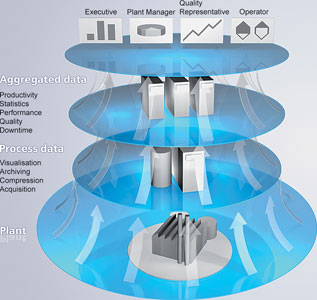

There is a growing demand for IT solutions that support time-saving targeted synchronisation of production processes, simplify these and make them more flexible.
The increasing volume of process data which needs to be processed and visualised for the purposes of more efficient resource planning, traceability, quality assurance and sustainability requires that the integration of corporate processes is both horizontal and vertical (the latter as widely as possible across the whole company). Siemens' scada system meets this challenge with extended functions for web-based analyses, ad hoc reports and characteristic value-based evaluations. Plant intelligence taps into the crucial added value of scalable plant transparency from the process level to the MES and ERP levels.
Corporate decisions these days demand the latest and instantly available information from the entire production environment. The key to this is not only in the efficient capture, preparation and display of relevant process data, but even more in its intelligent assessment, compression and distribution.
Traditional client server configurations have not kept up with this challenge. The worlds of scada and MES are converging and allowing the necessary transparency and depth of information. That is what is being offered by the Simatic WinCC process visualisation system and the Simatic IT MES solution from Siemens Automation and Drives with its integrated Simatic Plant Intelligence.
Tried and tested basic functions
As a scada system, WinCC has all fundamental HMI functions on board - from the alarm and event archive to measured value recording and documentation. Effective analysis options (eg, evaluating deviations from limit values and standards on the basis of graphs and diagnosing the frequency of faults) in the alarm and tag logging have been a component of the basic system for years.
Yet the wealth of automation data continues to increase and must be edited even more specifically and efficiently in order to allow increasingly transparent and flexible access from higher-level systems, independent of the actual storage location. WinCC/ConnectivityPack and WinCC/IndustrialDataBridge are tried and tested basic function blocks for this exchange of information with other databases via standard interfaces such as OLE and OPC.
WinCC/DataMonitor brings process and historic data into the office world, using standard tools such as Internet browsers and spreadsheet programs.
On the client side, Webcenter only requires Internet Explorer which means - like most of the Internet components for WinCC - it is installation-free for the user.
Webcenter pages can be linked to one another - for example, to link from one page to another that displays detailed historical diagrams, and in this way to analyse the frequency of faults during a night shift. Excel Workbooks can be made available as favourites in the Webcenter.
Published Reports contribute to the decision-making process by means of time- or event-controlled reports which can also be sent by e-mail as Excel or PDF files. Following analysis of the report, the process screens or web pages can be used for further queries.
Overall, this makes the WinCC/DataMonitor ideal as a process data server for several lower-level WinCC servers in a corporate network. But individual licences are also available.
Process optimisation and quality analysis
The primary objective of Simatic Plant Intelligence is the continual improvement of overall equipment effectiveness (OEE). Using the WinCC/ProcessMonitor and WinCC/DowntimeMonitor options, production and quality management receive realtime information and performance analyses from the process which decisively speeds up its optimisation.
The OEE is calculated according to a formula devised by the Japan Institute of Plant Maintenance as a product of availability, performance level and quality rating. The peak value is an OEE of 85%, whereas most plants in the production industry only achieve around 60% at present. In the new WinCC options, therefore, there is significant potential for operators to raise the efficiency of their plants.
WinCC/ProcessMonitor and WinCC/DowntimeMonitor use predefined software functionality and evaluate the respective process variables of a plant or of an individual machine.
After generating a time model and various plant statuses for operation, the WinCC/DowntimeMonitor can very easily take over the analysis of the equipment. A unit of equipment is defined as one machine, production line or part of a plant that is worth analysing separately. The analyses form the basis for optimising production. The evaluation is performed according to the criteria of the OEE and other key performance indicators (KPIs), such as MTTR, MTTA, MTBF, and MTBA. The KPIs are displayed in WinCC graphics.

Preconfigured, typical KPIs that also take the work-shift schedule into account are available for the DowntimeMonitor.
The various operating states are displayed in the Gantt View. The KPIs of the equipment are presented in four different display formats. The available formats are trend view, Pareto diagram, stacked bar charts and bar charts that are embedded in the WinCC displays.
The WinCC/ProcessMonitor is used for collecting, manipulating, evaluating and storing process values. The integration of ProcessMonitor into WinCC guarantees full transparency across all machines and plant data as a basis for the optimisation of plant productivity.
Process values are read directly from WinCC and linked with the corresponding analysis function. The values are monitored for limits, identified accordingly and archived with the additional information. Predefined equipment unit functions are used in order to compile the data and archive it with richer information content. Individual characteristic values that can arise from the production process can be defined and calculated on a customer-specific basis.
If process values or calculated KPIs exceed specified limits, they can be disregarded as irrelevant. Alternatively, these excessive values can be specifically used in WinCC for interrupt purposes.
Calculated KPIs can be written to WinCC tags for greater clarity and these can then be displayed in an overview with all the possible options of WinCC.
Three powerful controls show the relationship between calculated indicators and raw values. The trend representation, XY-chart or a message analyser are used for interpreting the data according to the situation.
Combined with the WinCC visualisation options, the ProcessMonitor is a powerful way of analysing and optimising processes.
Integrated migration capability as far as the MES level
Plant intelligence starts at the automation level. The entry into Simatic Plant Intelligence can take place by means of options for the Simatic WinCC process visualisation system or directly into the Simatic IT MES. The Siemens solution offers the possibility of a simple upgrade from process visualisation to a comprehensive optimisation solution at the MES level.
In summary, the new Simatic Plant Intelligence offers a practice-oriented basis for analyses, reports and the determination of process-relevant KPIs for the performance of a plant and its optimisation.
The new or extended WinCC options can ideally be used on a central WinCC Plant Intelligence server station. An upgrade is available for incorporating existing WinCC/DowntimeMonitor or WinCC/ProcessMonitor solutions seamlessly into the MES environment of Simatic IT OEE-DTM and Simatic IT PPA and for combining reliable process data analysis with additional options in respect of the data and quantity structures to be analysed.
Siemens regards the scalability of Simatic Plant Intelligence as unique within the field of scada systems. The integration with an MES solution facilitates shared interfaces, standardised operation and integrated data storage, minimises the expense of upgrading and guarantees the security of investment at a low total cost of ownership.
For more information contact Keshin Govender, Siemens Southern Africa, +27 (0)11 652 2412, [email protected], www.siemens.co.za
| Tel: | +27 11 652 2000 |
| Email: | [email protected] |
| www: | www.siemens.co.za |
| Articles: | More information and articles about Siemens South Africa |

© Technews Publishing (Pty) Ltd | All Rights Reserved